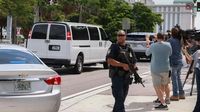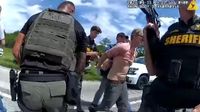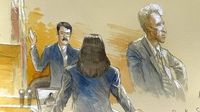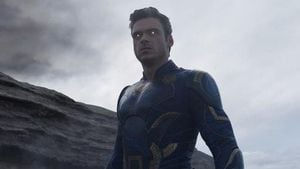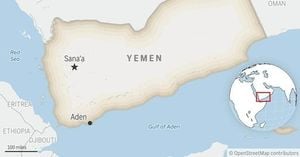The criminal trial of Ryan Routh, a 59-year-old construction worker accused of attempting to assassinate then-presidential candidate Donald Trump, has gripped a Florida courtroom with its extraordinary details, chaotic courtroom drama, and a backdrop of rising political violence across the United States. The proceedings, unfolding in Fort Pierce, Florida, have offered a rare and unsettling window into the calculated planning behind the alleged attempt, the frantic law enforcement response, and the erratic self-representation of the defendant.
According to ABC News, prosecutors allege that Routh meticulously plotted for weeks to kill Trump as he played golf at Trump International Golf Club in West Palm Beach on September 15, 2024. Routh, who has no legal training, chose to represent himself in court—a decision that quickly became a spectacle. On the first day of trial, Routh’s opening statement veered wildly off course, touching on topics as disparate as Adolf Hitler, the war in Gaza, and Russia’s invasion of Ukraine. Judge Aileen Cannon, a Trump appointee, twice dismissed the jury to address Routh’s digressions before revoking his right to continue his statement altogether. "I gave you one more chance and you continued to read what has no relevance for this case," Cannon admonished, as reported by Straight Arrow News and The Associated Press.
Prosecutors, led by Assistant U.S. Attorney John Shipley, wasted no time in laying out their case. Shipley told jurors that Routh’s motivation was explicitly political, quoting him as saying, "He [Trump] needs to go away." Shipley described the plot as "carefully crafted and deadly serious," highlighting that Routh had obtained military-grade rifles, ten burner phones, stolen license plates, and maintained a "trail of lies that extended all the way from Honolulu, Hawaii to West Palm Beach, Florida." The prosecution contends that Routh spent the month leading up to the attack living out of his car at a nearby gas station, obsessively tracking Trump’s movements online and preparing for the assassination attempt.
On the day of the incident, Routh allegedly concealed himself in the brush just outside the club’s fence, his SKS semiautomatic rifle at the ready. FBI Special Agent Katherine Rose presented the rifle, ammunition, scope, and magazine to the jury, as well as two metal plates that prosecutors say Routh intended to use as makeshift armor. Erin Casey, a media specialist with the FBI, brought the crime scene to life for jurors with a "fly-through" video reconstruction, showing exactly how close Routh’s sniper post was to Trump’s location on the golf course. "It’s like an animated camera in a Pixar movie," Casey explained, calling the video "a tool to bring you back to the scene."
The response from law enforcement was chaotic and tense. Kenneth Mayes, a sergeant with the Palm Beach County Sheriff’s Office, testified that his unit initially operated with little information due to radio channel differences between local police and the Secret Service. Mayes described arriving at the scene and shouting "Blue, blue!" to identify himself and avoid being mistaken for the shooter. Lieutenant William Gale recounted how a bystander, who had followed Routh’s fleeing vehicle and noted the license plate, provided the crucial tip that led to Routh’s eventual arrest on a nearby interstate.
Secret Service agent Robert Fercano, who was patrolling the course in a golf cart, testified that he came within five feet of Routh before spotting the muzzle of the rifle through the bushes. Fercano recalled, "I wasn’t physically harmed, but I was mentally harmed from you pointing a gun at me." The Secret Service opened fire, prompting Routh to drop his weapon and flee without firing a shot. Trump was unharmed, but the close call underscored the seriousness of the threat and the professionalism required to avert disaster.
Adding a bizarre twist to the case, four witnesses testified about the discovery of an empty can of Vienna-style sausages near Routh’s alleged sniper perch. Prosecutors argued that this detail linked Routh to the scene, especially after showing jurors a selfie Routh had sent to his romantic partner from his car, with the same sausages visible in the background. Assistant U.S. Attorney Shipley emphasized that the sausages were more than a quirky detail—they were a tangible piece of evidence tying Routh to the crime scene and the preparations for the attack.
The prosecution’s case moved at a brisk pace, with multiple law enforcement witnesses called in rapid succession. FBI Special Agent Jose Loureiro testified about the chain of custody for Routh’s car, while Special Agent David Gilbert described the process of disarming the rifle. Digital analyst Elizabeth Reidel discussed the trail camera found at the alleged sniper perch, revealing that most of the footage dated from August 2024, coinciding with Routh’s arrival in Florida. Special Agent Tristan Bailey detailed the collection of DNA and fingerprint samples from Routh, while also fielding Routh’s unusual compliments and complaints about the evidence process during cross-examination.
Despite the gravity of the charges—which include attempted assassination of a major presidential candidate, assaulting a federal officer, and multiple firearm violations—Routh’s self-representation has injected an unpredictable element into the trial. At times, he has made off-topic remarks, praised witnesses, and conducted brief, unconventional cross-examinations, even referring to himself in the third person. After one witness’s testimony failed to advance his case, Routh quipped, "Seems like we got nowhere. Thanks for your useful testimony."
Judge Cannon has occasionally rebuked both sides for procedural missteps, but the pace of the trial has surprised even the prosecution, who initially estimated a three-week duration but now expect to rest their case ahead of schedule. The trial resumed on Monday, September 15, 2025, after prosecutors exhausted their witness list the previous week.
The Routh trial comes amid a disturbing wave of political violence in the United States, as highlighted by Straight Arrow News and The Associated Press. In the months before and after the Trump golf course incident, multiple politicians and activists have been targeted. Just nine weeks prior, Trump survived another assassination attempt at a campaign rally in Pennsylvania. Recent months have also seen the killing of conservative activist Charlie Kirk on a Utah college campus, the murders of Minnesota state Rep. Melissa Hortman and her husband, and arson at the home of Pennsylvania Governor Josh Shapiro. The context has left many Americans questioning the security of their political leaders and the stability of the country’s democratic institutions.
As the trial of Ryan Routh continues, the courtroom drama, the forensic details, and the broader national anxieties it evokes serve as a sobering reminder of the stakes involved when political passions turn violent. The outcome of the case will be closely watched—not only for the fate of one man, but for what it may signal about the state of American democracy in turbulent times.
